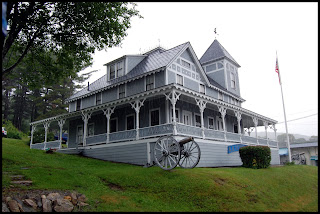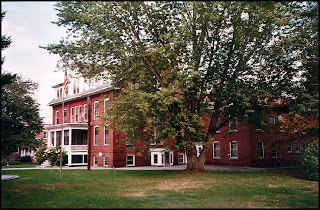“The law passed in 1885 for the relief of indigent soldiers had an excellent purpose, but its execution has shown some defects. As such persons are to be supported, according to this law, by the towns or cities where they live, overseers of the poor very naturally have classed them with paupers. Many feel humiliated by the name, and therefore refuse to accept the support they deserve. As these men were sent to the war by the State, it would seem that the State should furnish the proper relief, and thus take away the stigma of pauper.”
Governor’s Message, State of New Hampshire Annual Report, 1889
The effects of the Civil War on New Hampshire’s built landscape did not create scarred battlefields and destroyed communities, but it did create several new types of buildings to serve and shelter those who suffered from the war’s consequences. Wounded soldiers needed care, and orphaned children a caring home. Soldiers and family members connected by their shared war experiences established social organizations and built headquarters for their recreational, political and benevolent activities.
Among the most well-known organizations to come out of the Civil War experience was the Grand Army of the Republic (GAR), founded in 1866 in Decatur, Illinois. It quickly became the preeminent veterans’ association, with more than 400,000 members, organized into thousands of posts and united by the organization’s objectives of fraternity, charity and loyalty. More than 90 societies were founded in New Hampshire. Today, GAR meeting halls and memorials are the most visual reminder of these organizations and their influence in communities across the state.
More unique to our state was the New Hampshire Veterans’ Association, founded in 1875 and incorporated in 1881. Although established by Civil War veterans, the association later expanded its membership to include veterans of all American wars. The organization held the first of many reunions in the 1870s at Weirs Beach on the western shore of Lake Winnipesaukee. By the 1880s, different regiments began building cottages on the site; by 1924, 35 buildings housed summering veterans and various recreational activities such as dances and concerts. Today, the Queen Anne style cottages are a landmark at the Weirs, overlooking the lake, the beach and busy Lakeside Avenue.
In 1888, as the country began to comprehend the full responsibility of caring for aging and disabled Civil War veterans, Congress passed federal legislation to fund the establishment of state-operated veterans’ homes. In 1890, with support from philanthropist Charles E. Tilton, New Hampshire opened the New Hampshire Soldiers' Home in Tilton, the first state to do so. Now known as the New Hampshire Veterans Home, it has cared for thousands of veterans and their families in the years since.
The children and families of lost soldiers also required care in the tumultuous years that followed the Civil War. The Rev. Daniel A. Mack served as a chaplain during the war. The dying concerns of soldiers are said to have inspired Mack to work with a number of philanthropists to establish a home for orphans on Daniel Webster’s 200-acre family farm in Franklin. Built on rolling farmland along the Merrimack River – a place Webster had said was “the most beautiful place on this earth” – the home was one of the first rural orphanages established in the country.
Sources and Further Reading
Child, William H. History of the Town of Cornish. Concord, NH: Rumford Press, n.d. http://www.ebooksread.com/authors-eng/william-h-child/history-of-the-town-of-cornish-new-hampshire-with-genealogical-record-1763-19-lih/page-9-history-of-the-town-of-cornish-new-hampshire-with-genealogical-record-1763-19-lih.shtml, accessed May 14, 2012.
http://www.loc.gov/rr/main/gar/, accessed on May 9, 2012 .
Mausolf, Lisa B., “Colburn Park Historic District,” National Register of Historic Places Nomination, 1986. In the collection of the New Hampshire Division of Historical Resources, Concord, NH.
Muzzey, Elizabeth H. “Webster Farm Area Form,” 2005. In the collection of the New Hampshire Division of Historical Resources, Concord, NH.
O’Neill, Thomas E. “New Hampshire Veterans’ Association Historic District,” National Register of Historic Places Nomination, 1980. In the collection of the New Hampshire Division of Historical Resources, Concord, NH.
http://www.rootsweb.ancestry.com/~nhnhs/GAR.html, accessed on May 11, 2012





No comments:
Post a Comment